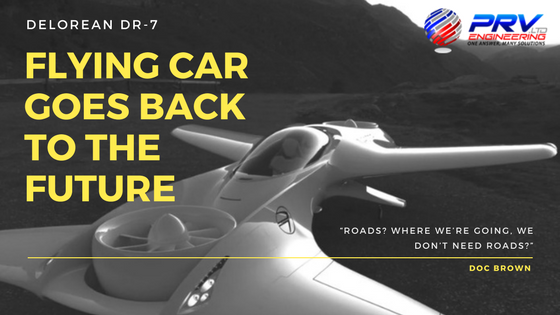
Technology is at the point where talking about a flying car should come as no surprise. This can be attributed mainly to the new lightweight material, improved batteries, advanced computer technology and controls. According to reports, DeLorean Aerospace is in the process of developing a two-seater VTOL aircraft called the DR-7. This puts Paul DeLorean in a whole new category along with Airbus, Uber, Darpa and the likes of Larry Page.
The DeLorean is best remembered for the time-traveling sports car from Back to the Future films piloted by Doc Brown. Who would have thought his quote would ring true a few decades later; “Roads? Where we’re going, we don’t need roads?” They did fly the car at the end of the first film but now the DR-7 is set to make the flying car more than just science-fiction.
What sets this flying car apart?
The real difference between the DR-7 and other flying car designs is the simpler, cheaper and better performing engines. There is a front- and rear-mounted engine with 360-degree thrust vector control housed in a streamlined fan engine casing. The centerline twin vectoring system (CTV) means that the fans are not only used for propulsion, but also for control.
There are two modes; horizontal and vertical.
- Horizontal mode provides lift and hovering which means it can be used nearly anywhere. This includes shorter landing fields, your front lawn, garage, roof or custom-built ‘VTOL-pad’.
- Vertical mode propels the craft forward and the tilting fans could essentially replace the conventional fin and rudder to reduce drag.
Overall it’s more reliable and provides greater stability. Combining rotating lift and propulsion fans with an autonomous flight control system, makes this flying car relatively easy to operate. There is good news for the more experienced aviators though. The autonomous flight system can be changed to manual for a more exhilarating ride, or should we say flight?
Features and specifications of the DeLorean flying car
Without a doubt, the DeLorean DR-7 is at the top of the list with superior design and engineering. The composite monocoque body and highly-efficient wing design are only two reasons why.
The short, hinge-and-pivot wings can fold in against the sides allowing for easier storage in a garage or parking space. The modern electric power system also means that the craft has a zero-emissions rating. What’s not to like about any of these specs?
- Length: 19.5 ft (6 m)
- Wingspan: 18.5 ft (5.6 m)
- Folded width of 7.5 ft (2.3 m) with wings tucked in
- Composite monocoque fuselage with tandem seating
- Stall-resistant canard wing
- Rechargeable electric powertrain
- Top speed of 240 mph (386 km/h)
- Cruise speed of 150 mph (241 km/h)
- Low drag coefficient allows for extended range of about 120 mi (193 km)
Putting it all into perspective
They have already developed two models for proof of concept and engineering but no confirmation yet on cost or release date. A full-size prototype is next on the agenda with predictions of a launch toward the end of 2018.
The DR-7 is more than just a toy for the rich and famous; it’s suitable for private use or even as urban air taxis. This is particularly relevant as Dubai is launching their flying taxis later this year with an aim to make public transport more autonomous by 2020.
Like others, DeLorean also has a vision to realise the dream of personal, practical and accessible air transport. As much as a flying car could be the answer, has anyone really thought this through? How will this work in relation to air traffic control? How do we avoid mid-air collisions? Please share your thoughts on this; we’d like to hear from you.
PRV Engineering is an award-winning, world-class provider of CNC precision engineering. Our expertise covers a range of industries including automotive, rail, aerospace, defense and construction. Get in touch if you need help with your projects.
This site uses Akismet to reduce spam. Learn how your comment data is processed.


 Mail:
Mail: 




Leave a Comments